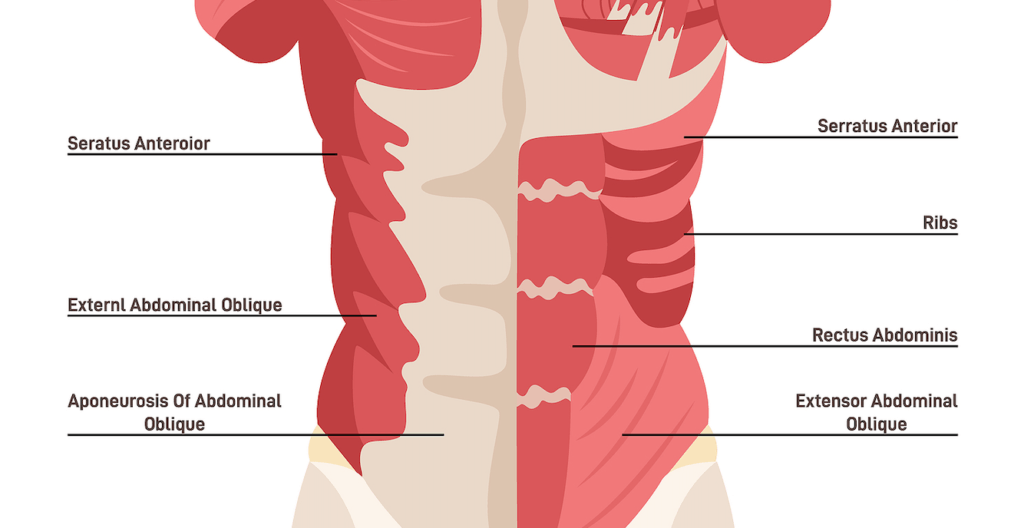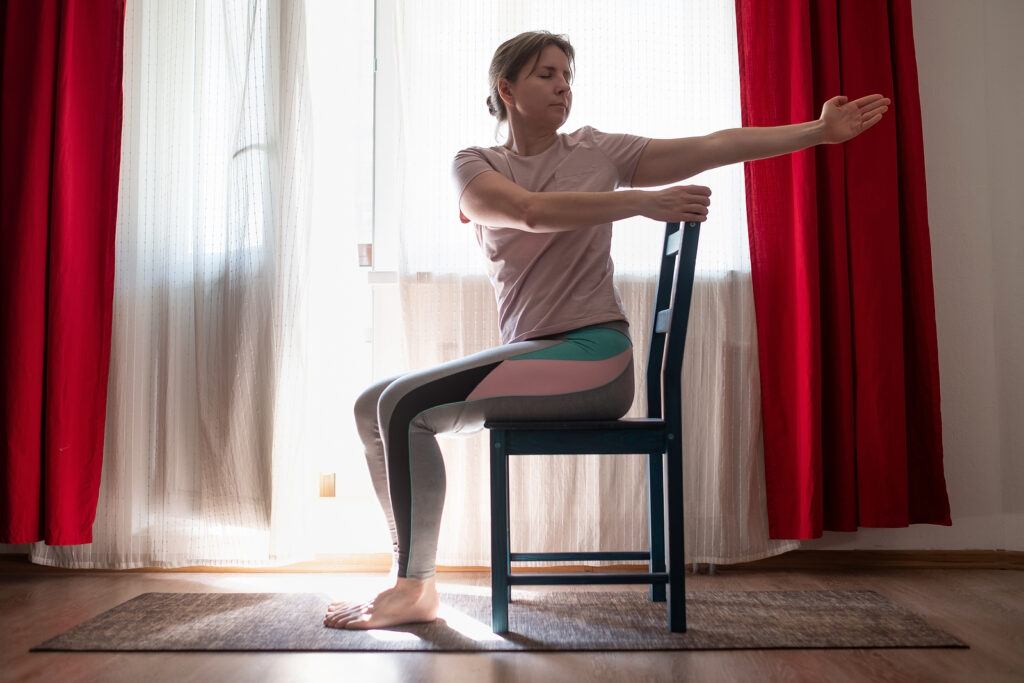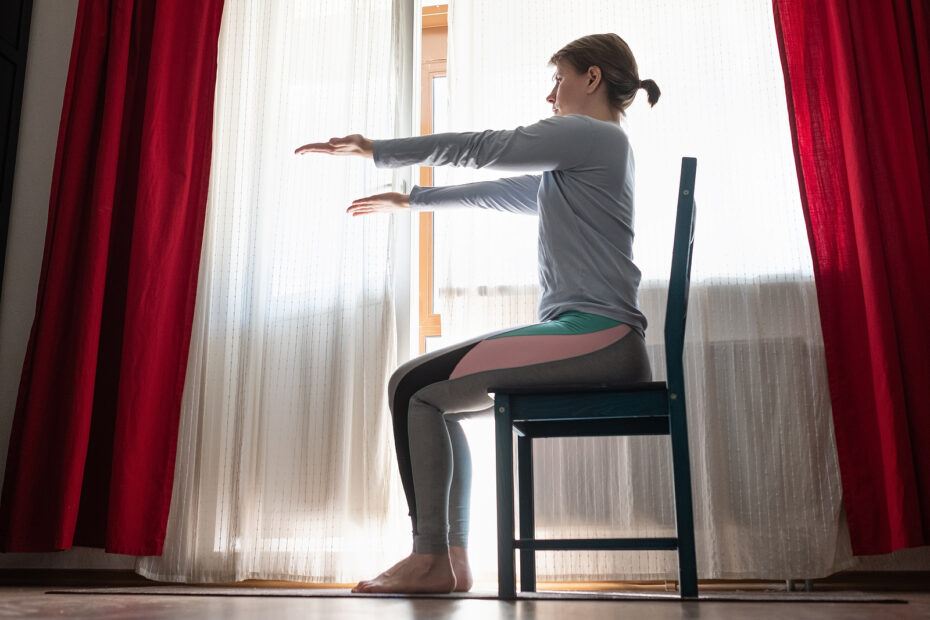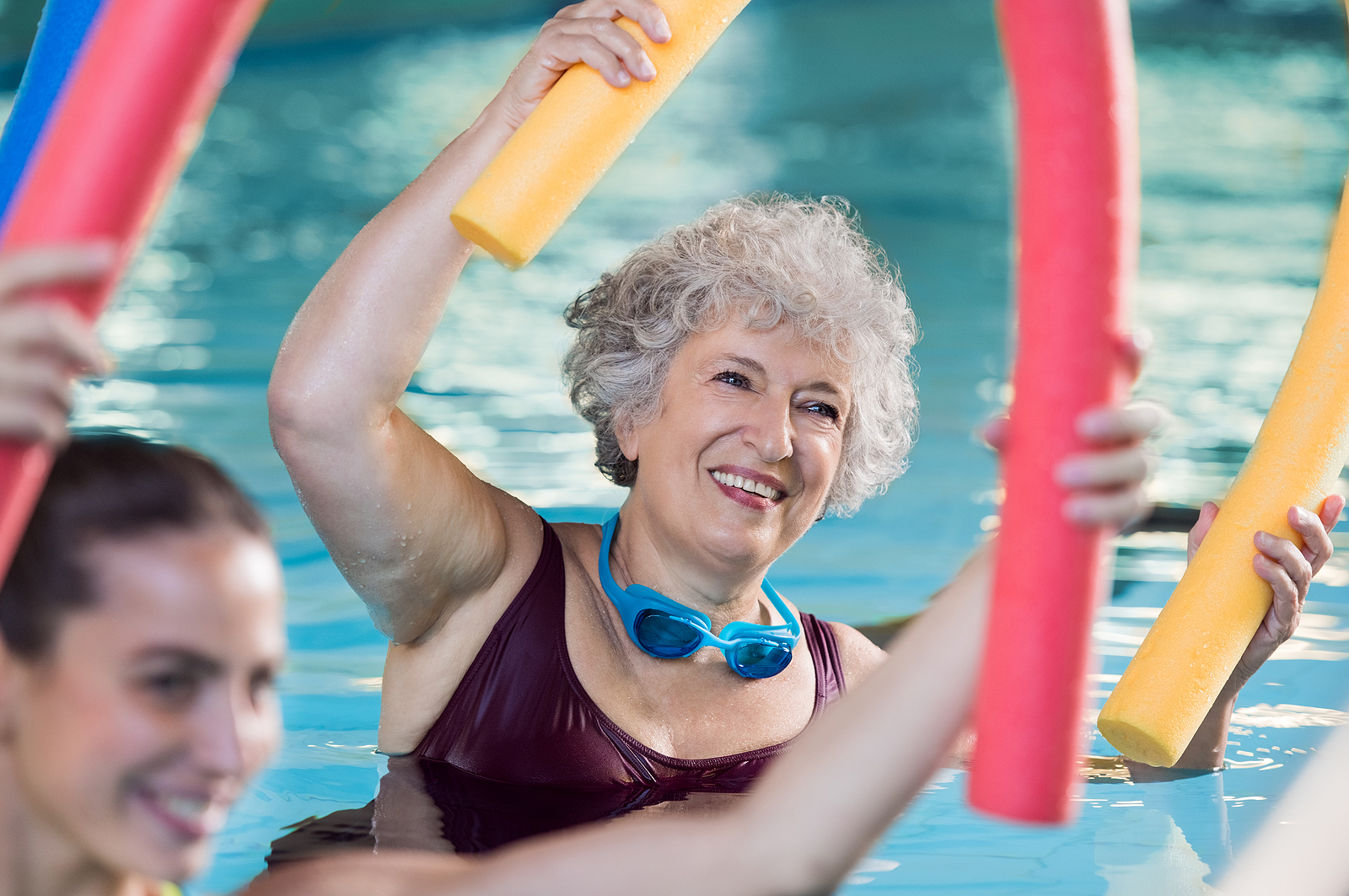A strong core supports good posture, reduces the risk of falls, and makes everyday activities like bending, lifting, and walking easier.
It also helps protect your spine and prevent injuries during daily activities.
In other words, maintaining a strong core is really important, especially as we age.
Fortunately, there are a ton of different ways to strengthen these important muscles, many of which can be done while sitting.
And for seniors with limited mobility or balance concerns, seated core exercises offer a safe and effective way to strengthen these vital muscles, without the need for strenuous or standing movements.
In this post, we’ll explore the best seated core exercises for seniors, as well as provide additional tips to help get the most out of your workouts.
After reading, you’ll be ready to start adding core moves to your workouts.
But first things first…
Why Core Strength Matters
The core isn’t just about your abs – in reality, it includes muscles in your abdomen, back, hips, and pelvis.
What counts as a “core” muscle may vary depending on who you ask, but most generally agree that pretty much any muscle between your shoulders and hips can be included in this list.
Semantics aside, your core muscles are a very important group.
And that’s mostly because these muscles work together to provide stability for your spine and pelvis, helping you maintain balance and move efficiently.
We could go on for days about this topic, but here’s the abridged version of why core strength is especially important for seniors:
- Increased Independence: A strong core makes it easier to perform daily activities, such as getting up from a chair, carrying groceries, or reaching for objects.
- Improved Balance: A strong core can reduce the risk of falls by improving your ability to maintain stability during everyday movements.
- Better Posture: Core muscles help support good posture, which reduces strain on the spine and joints.
- Reduced Back Pain: Strengthening the core can alleviate pressure on the spine, reducing the risk of lower back pain.
In other words, having a strong core makes everything just a little bit easier – and considering most things become more challenging as we age, we should take every advantage we can get.

Safety Tips Before Starting
The seated exercises discussed below are low-impact and should be considered safe for most seniors, but we still need to be careful.
Before starting any new exercise routine, it’s important to keep in mind:
- Consult with Your Doctor: Always check with your doctor or physical therapist before beginning a new exercise program, especially if you have any existing medical conditions.
- Start Slowly: Begin with gentle exercises and gradually increase intensity as your strength improves.
- Use a Stable Chair: Perform these exercises in a sturdy chair with a straight back to ensure good posture and support.
- Listen to Your Body: If any movement causes discomfort or pain, stop immediately and try a modified version.
Now, let’s get to the good stuff…
Helpful tip – to get the most bang for your buck, try to gently pull your belly button in and hold it while doing the below exercises (without holding your breath). This contracts your transverse abdominus (TA) muscle, an important core stabilizer.
Safe & Effective Seated Core Exercises for Seniors
1. Sitting Unsupported
This is a great beginner exercise and will be more challenging than you think for seniors with poor core strength.
It’s also a good starting position for more difficult exercises down the road.
- Scoot to the edge of your chair so that your back isn’t touching anything
- Keep your feet planted on the floor and rest your arms down by your side
- Maintain an upright posture while sitting without touching anything
- Hold for 30 -60 seconds, repeat 3-5x
2. Seated Marching
This simple exercise gets the hip flexors involved and is a nice progression from the exercise mentioned above.
- Sit tall in your chair with your feet flat on the floor and your hands resting down by your sides
- Slowly lift your right knee toward your chest, engaging your abdominal muscles as you do
- Lower your right leg and repeat with the left leg
- Alternate legs in a slow, marching motion
- Repeat 10-15x for each leg (or for 30 seconds); repeat 3x
This exercise can be done with the back supported, but it’s more effective when done with the back unsupported.
3. Seated Trunk Rotations
Trunk rotations are an excellent way to engage the obliques, the muscles on the sides of your abdomen, which help with rotational movements and balance.
- Sit with your feet flat on the floor and your back straight (preferably unsupported)
- Cross your arms over your chest or hold a small object (like a water bottle) in front of you
- Slowly twist your upper body to the right, keeping your hips and lower body stable
- Return to the center and twist to the left
- Repeat for 2-3 sets of 10 reps
If you have achy shoulders, feel free to keep your arms crossed in front of your chest, but keeping your arms extended out in front of you makes this exercise a little more challenging.
You could also try holding a small dumbbell, can of soup, or other lightweight object out in front for added resistance – but keep it light, it doesn’t take much weight to get the job done.

4. Seated Trunk Diagonals
This core exercise takes the trunk rotations and adds an extra layer of mobility and the result is a fantastic move that works a lot of muscles at the same time.
Full disclosure, you need a decent amount of spinal and upper body mobility to perform this one, so it may be challenging for seniors with limited mobility.
- Sit at the edge of your chair with back unsupported and feet flat on the floor
- Bring your arms straight out in front and together, rotate to the right, and bend down toward the floor (your arms should be on the right side of your right leg)- this is the starting position
- Extend your back and rotate to the left, while trying to raise your hands over your left shoulder
- Hold for a second and then return to the starting position
- Do 10 reps in this manner and then switch and repeat on the other side (starting down beside your left leg and turning to the right)
I hope that description makes sense, I know this is kind of a hard exercise to describe in writting.
You’re basically rotating in a diagonal motion, starting at one knee and finishing over the opposite shoulder.
Here’s a link to YouTube if you’d like to see a video (I prefer to have the arms extended in front, but the folded arms variation works well too).
5. Seated Marching with a Twist
This exercise combines marching with a trunk rotation, targeting both the lower abs and obliques for a more comprehensive exercise.
This exercise will challenge your coordination too.
- Sit up straight with your feet flat on the floor
- Place your hands behind your head or across your chest
- Lift your right knee toward your chest while simultaneously twisting your upper body to bring your left elbow toward the lifted knee
- Lower your leg and return to the starting position, then repeat on the other side
- Continue alternating sides for 10-15 repetitions to each side
- Repeat 2-3x
6. Opposite Arm/Leg Raises
Here’s another more difficult variation of the marching in place exercise that’ll challenge your core and coordination at the same time.
Again, to get the most out of this exercise, try to sit with your back unsupported.
- Sit at the edge of your chair with feet flat on the floor
- Raise your right knee up toward your chest while simultaneously elevating your left arm up toward the ceiling
- Hold for a second, and then return to the starting position and repeat on the other side (left leg, right arm)
- Continue alternating sides, repeat for 10-15 reps to each side
You can modify how high you raise your hands to match your shoulder range of motion; you can also choose to keep your elbow straight or bent while moving arms.
7. Seated Banana
I called this one the “seated banana” because it’s a seated variation of a popular supine exercise known informally as “banana” (and more formally as the hollow hold).
It’s a cute name, but a challenging core exercise.
- Sit at the edge of your chair with feet flat on the floor
- Extend both knees so that both feet are now off the floor (not marching, hips stay put)
- Gently lean back toward the backrest as far as you can while maintaining your seated position (back shouldn’t go all the way to backrest)
- Lift both arms over head and hold
- Aim for 30 – 60 seconds and then rest
- Repeat 2-3x
It’s important to keep your core muscles tight and engaged during this one and lean back slowly to keep everything controlled.
This is a more challenging exercise and best attempted only after mastering the easier exercises mentioned above.
Incorporating These Exercises Into Your Routine
For best results, try to perform these seated core exercises 3-4 times a week.
They can easily be done at home, and you can adjust the intensity by adding more repetitions or holding the movements longer.
You can also combine these exercises with other seated movements, such as arm or leg exercises, to create a full-body workout.
I’ve mentioned a few times already that you it’s best to try these exercises while sitting with your back unsupported because it’ll make your core muscles work harder to stabilize.
Well, you can make things even harder by sitting on an unstable surface, like a Swiss ball (huge inflatable ball used for exercise).
Just know that doing these exercises on a Swiss ball makes them A LOT harder, so please don’t try it if you have a hard time with any of these on a chair.
Also, don’t feel as if you have to perform all of these exercise at a time because that would be a lot.
I’d suggest picking 3-4 and seeing how they feel.
Depending on your fitness level, you may want to start at the beginning and simply practice sitting unsupported.
Seniors with more core strength can start somewhere in the middle or near the end and progress as tolerated.
Final Thoughts
Seated core exercises are an excellent option for seniors with mobility issues or who become fatigued easily with standing.
But these exercises are also great for folks looking to strengthen their core muscles without the need for strenuous or high-impact movements.
Either way, these exercises can help improve core stability and posture, both of which are important for reducing the risk of injury during daily activities.
So, whether you’re new to exercising or looking for a safe way to stay active, these simple seated exercises can be a great addition to your fitness routine.
Again, always remember to consult with your healthcare provider before doing any exercises you aren’t sure about.
And listen to your body to ensure you’re working within your comfort zone – you shouldn’t feel pain during any of these exercises!
If anything hurts, please check your form or discontinue all together if necessary.
And remember, the key to improving strength and safety is staying consistent – these things take time.
Well, I guess that about does it.
If you have any questions or have any favorite seated core exercises that deserve a spot on this list, please leave ’em below and I’ll get right back to ya.



